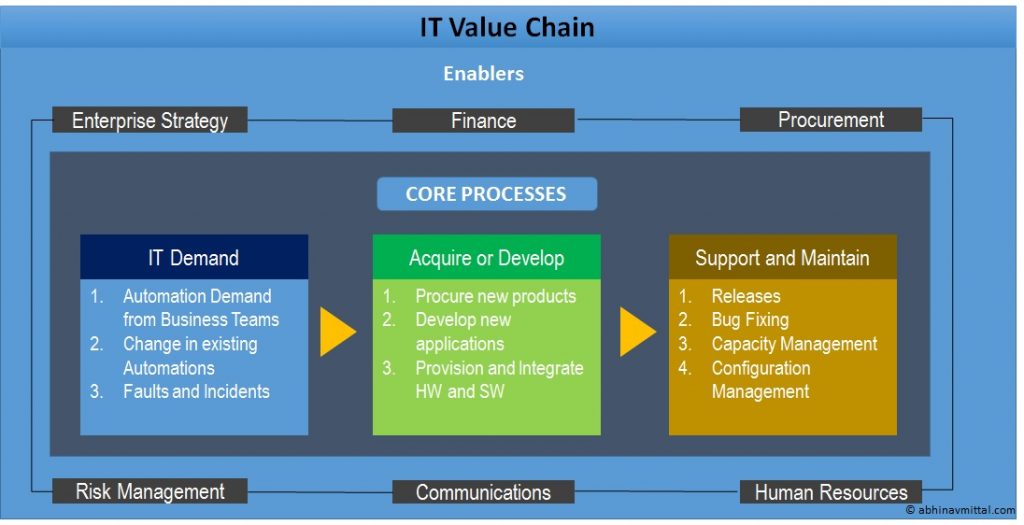The Curious Case of Benevolent CIO

The CIO (Chief Information office) or Head of IT is a very interesting role in an enterprise landscape, Having the opportunity of closely working with CIO’s, I have realized that Of all the CXO roles, (CFO, CHRO, CMO etc.), The CIO’s are the most benevolent when it comes to spending on technology to keep their own house (IT Function) in order.
The message is reinforced by all leading IT and management Analysts who call IT as Partner, Catalyst and hold it’s importance in driving organization change. This ensures that the CIO spends all of his time and budget in delivering world class processes and tools which help the Business/Sales and Marketing/Finance/HR and everyone else manage their KPI better.
At the time of annual budget, all business leaders lobby hard to ensure their automations are approved, many of them see automations as way to keep their teams happy and secured from becoming redundant. Business side automations continue to happen like this in name of productivity, compliance and growth.
Knowing this, technology vendors leave no stone unturned and send their army of sales teams to chase the business heads, completely ignoring the CIO on their way. The CIO who has often worked hard throughout the year optimising each and every dollar of IT budget. Once again falls victim to this new business requirement which is routed by business heads through the CEO/CFO.
So after business pushes new Adhoc spend in the Annual IT budget, hell breaks loose for the CIO, Who is now is asked to bring his IT budget in certain % of revenue. The CFO (Influenced by Another vendor/consultant) pushes some difficult questions to CIO such as (How much percent of Network budget is consumed by Employees surfing Facebook/YouTube , What is the ROI of security application for which we paid a million dollars, How many employees are actually benefitting from the 100 Software licences we brought last year). Since a lot of spend on these was business driven, and all IT did was purchasing and provisioning, Our CIO is often caught with his neck deep in water.
The problem of measuring IT costs at an activity based level is much more challenging and requires complex alignment of Financial and IT Operations tools, all of which have to work in tight cohesion with various vendor products. There is a underlying hardware which could be on premise or hosted, There is the operating system, storage, middleware software, application software, security appliance, network gear and bandwidth, On top of that there is the project cost, support cost, training and change management costs. Moreover these discrete elements which make the Service Costing are spread across various cost centres and accounting policies, making the job of IT-Financial reporting on business benefits even more difficult.
Once again in absence of right tools to track IT-Financial costs and benefits, The CIO ends up getting arbitrary cuts in his budget. Starting the vicious circle of not having enough money to invest on his own IT.
In spite of all these challenges in measuring IT. The CIO is still responsible for managing all the complexity created around multiple technologies, platforms, and people (Internal and Outsourced). He has to ensure that all the IT enabled services are running and the promised projects are delivered within scope, time and cost. So while everyone’s life keeps getting better with enough IT tools to run their department, The CIO himself has little to depend upon.

IT Value Chain
A simplified view of IT Value Chain will show that a CIO needs to manage 3 core processes (Track Demand, Acquire or Develop IT and provide Maintenance and Support). Their core activities are then enabled by having aligned Enterprise Strategy, IT-Finance, and Procurement, Human Resources, Communication and Risk Management functions.
Unfortunately there is no mature and integrated solution which caters to all of this. The biggest of ERP and technology vendors (SAP, Oracle, Microsoft, IBM, CA, BMC, HP) have all good product roadmaps, however a robust solution still appears long away.
As of 2013 , The only logical solution seems to be using a “Necklace” approach wherein the middle diamond one can be a one of (CA,HP,IBM,BMC) surrounded by SW pearls by (SAP-Solution Manager, Microsoft,Cisco,Symantec, etc). The common thread across them has to be a custom build BI with an actionable IT dashboard and workflows on top.
Such a project will require big pockets and will have difficult internal selling cycle as already IT for IT has often been most deprioritized IT spend. Moreover CEO/CFO who find difficult to justify IT cost to boards are unlikely to take this up unless they see this investment paying for itself in 12-24 months.
So with no real solution in sight, The CIO’s would continue to remain altruistic, With a wishful thinking that Benevolence will evolve into good relations with business teams, which would will pay for itself.
Written by Abhinav Mittal, Abhinav is Author & IT Productivity Coach based out of Dubai, He has a more than a decade of experience in helping business leaders get more value from their IT investments
Contact Abhinav on ![]() for practical advise for securing funding for automating your IT Investments
for practical advise for securing funding for automating your IT Investments








